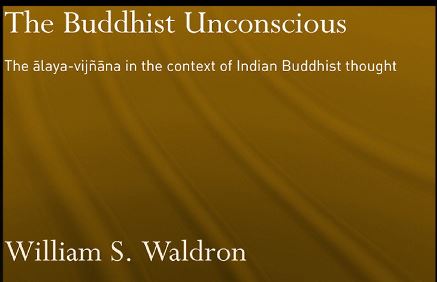
First published 2003 by Routledge Curzon, 11 New Fetter Lane, London EC4P 4EE
Simultaneously published in the USA and Canada by Routledge Curzon, 29 West 35th Street, New York, NY 10001
Routledge Curzon is an imprint of the Taylor & Francis Group
© 2003 William S. Waldron
THE BUDDHIST UNCONSCIOUS
The alaya-vijñana in the context of Indian Buddhist thought
William S. Waldron

William S. Waldron received his PhD in Buddhist Studies from the University of Wisconsin after studying extensively in India, Nepal, and Japan. Professor Waldron teaches courses on the South Asian religious traditions of Hinduism and Buddhism, Tibetan religion and history, comparative psychologies and philosophies of mind, and theory and method in the study of religion. His publications focus on the Yogacara school of Indian Buddhism and its dialogue with modern thought. Professor Waldron has been at Middlebury College since 1996. His monograph, The Buddhist Unconscious: The Ālaya-vijñāna in the Context of Indian Buddhist Thought, was published by Routledge Curzon in 2003. (Source Accessed April 15, 2020)
THE BUDDHIST UNCONSCIOUS
This work focuses upon an explicit notion of unconscious mind formulated by the Yogacara school of Indian Buddhism in a series of texts from the third to the fifth centuries CE. These texts describe and defend this “Buddhist” unconscious through a variety of exegetical and metapsychological arguments whose rationales are analyzed in terms of their historical and contemporary context. The work thus first presents the multivalent conception of consciousness (vijñana) within the early teachings of the Buddha, and then demonstrates how the Abhidharma emphasis upon momentary and conscious processes of mind was widely understood to make the continuity and multidimensionality of consciousness problematic in several crucial ways. The Yogacara thinkers addressed these multiple problems with a new model of mind centered upon the Buddhist unconscious, whose meaning and purpose is now made accessible to Western readers for the first time.
PREFACE
Our lives in this world are prescribed in countless ways. As human beings, we have certain capabilities, such as speech, but not others, such as natural flight or sonic navigation. As males or females, we inherit obvious as well as some not so obvious biological and social conditions. As Americans, Chinese, Indians, or Russians, we are acculturated from birth into particular world-views, with all of their attendant behavioral norms, cognitive regularities, and moral imperatives. Our actions in this life have done little to create the conditions in which we are born and raised, which nevertheless strongly circumscribe the parameters of our daily experiences.
This is no less true for our capacities of mind. The range of our normal perceptions, our typical array of appetites and aptitudes, even our capacities for our highest worldly achievements – to the extent that these are species-specific – are in large part already inscribed by the time we are born as human beings. Most of us, for example, cannot choose whether or not to see the sun as yellow or to feel pain when injured, or to become fearful or angry when physically assaulted. Most of this happens automatically, without our conscious choice and relatively impervious to our conscious intentions. This “unconscious structuring of experience” has been recognized to varying degrees, and with varying degrees of sophistication, in different times and places.
The essay that follows is the story of one such time and place – fifth-century CE India – where an awareness of this area of unawareness, and the challenges it poses to conscious self-transformation, were developed to an extraordinary degree. So much so that the Indian Yogacara Buddhists who first systematically conceptualized this awareness of unawareness, if you will, felt able to describe its dynamics and delineate its contours in considerable detail. They not only explicitly differentiated a dimension of unconscious mental processes – called “alaya” vijñana, the “basal, store, or home” consciousness – from the processes of conscious cognitive awareness – called pravgtti-vijñana. They also articulated a variety of experiential, logical, and exegetical arguments in support of this concept of unconscious mind, arguments which we will examine in considerable detail in the several Yogacara chapters below, which form the core of this work.
This “Buddhist unconscious,” however, did not arise out of a vacuum. The description of this “alaya” consciousness, as well as the problematics driving its development and the rationales offered in its defense, all evolved within a particular intellectual and religious milieu: the sophisticated traditions of Abhidharma Buddhism (roughly 200 BCE to 600 CE). Despite their (sometimes deserved) reputation for a scholasticism “as dry as dust,” Abhidharma traditions evinced great intellectual vitality. Driven by religious conviction, informed by yogic practice, and expressed in a systematic, albeit painstaking, idiom, Abhidharmic modes of analysis have indelibly influenced Buddhist thought and practices ever since. These traditions developed philosophical analyses of mind and mental processes to such a degree that its practitioners became acutely aware – experientially as well as intellectually – of the underlying conditions and constraints of ordinary, and even extraordinary, forms of conscious awareness. It was within this milieu that the complex concept of alaya consciousness developed, and within which the intricate and interwoven rationales supporting this “Buddhist unconscious” are most intelligible. The rationales for this concept are too dense, assume too many doctrines, and are simply too technical to be fully appreciated outside of this Abhidharma context. The second chapter is therefore devoted to providing the indispensable specifics of this originating context.
The Abhidharma traditions did not develop out of a vacuum either. They represented, more or less, a systematization of the teachings passed down from the Buddha himself. In these early teachings there was no overt distinction between consciousness (Sanskrit: vijñana; Pali: viññafa) as waking, object-oriented cognitive awareness and as a persisting, underlying level of basic sentience. The single term “vijñana” encompassed both these connotations. This distinction is discernable, however, through careful analysis of these early teachings, particularly in the light of later developments. This was, in fact, exactly how the Yogacarins justified their innovative distinction between conscious and unconscious mental processes: by examining the earlier teachings in the light of the later, more sophisticated perspectives of Abhidharmic analysis. We follow in these illustrious footsteps and turn first to the earliest teachings of the Buddha, focusing in particular on the concept of vijñana (viññafa) – rendered there equally appropriately as either “consciousness” or “cognitive awareness.” This, along with materials introductory to the basic Buddhist world view for the benefit of non-specialists, comprises the bulk of Chapter 1.
Although we by no means set out to replicate or validate the Yogacara interpretation of the early concept of vijñana, our study of these same teachings led us to similar conclusions: the “two aspects” of vijñana which were originally undifferentiated in the early texts became increasingly, and untenably, problematic within the Abhidharma context, eliciting in its wake various conceptions of non-conscious mental processes, only one of which was the “alaya” vijñana. We will therefore briefly examine these other responses to the same set of problems – the continuity of karmic potential and the latent afflictions, and their gradual purification along the path of liberation – together with the other Abhidharma materials in Chapter 2, before turning our attention squarely on the alaya-vijñana itself, as it is most systematically presented and described in key Yogacara texts, in Chapters 3–5.